The S&P 500 index
In this article, Nithisha CHALLA (ESSEC Business School, Grande Ecole Program – Master in Management, 2021-2023) presents the S&P 500 index and details its characteristics.
The S&P 500 index
The performance of 500 major capital companies listed on the US stock exchange is summarized by a financial index called the S&P 500 index. The stocks of the S&P 500 index are traded on the New York Stock Exchange and NASDAQ, which are the two major stock exchanges in the United States of America. This index serves as a benchmark for the American stock market and investors use it to monitor the performance of the market. The selection of 500 stocks only is deemed enough to represent the stock market (in terms of market capitalization).
The S&P 500 index was first established by Standard & Poor’s, a provider of financial services, on March 4, 1957. In order to provide a comprehensive assessment of the U.S. stock market, the index consists of a range of large-capital businesses from various industries and sectors. The S&P 500 index is currently managed by the index provider S&P Dow Jones Indices (a division of S&P Global).
Who makes the shortlist of the index and how the field is narrowed down? The S&P Dow Jones Indices oversees the selection procedure for index inclusion. The public float, financial viability, market capitalization, and a diverse representation of the US stock market—including technology, healthcare, financials, consumer goods, etc.—are some of the key criteria used to define the composition of the index.
How is the S&P 500 index represented in trading platforms and financial websites? The ticker symbol used in the financial industry for the S&P 500 index is “SPX”.
Table 1 gives the Top 10 stocks in the S&P 500 index in terms of market capitalization as of January 31, 2023.
Table 1. Top 10 stocks in the S&P 500 index.

Source: computation by the author (data: YahooFinance! financial website).
Table 2 gives the sector representation of the S&P 500 index in terms of number of stocks and market capitalization as of January 31, 2023.
Table 2. Sector representation in the S&P 500 index.
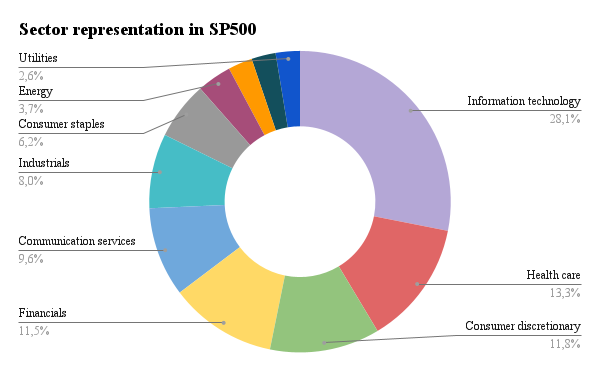
Source: computation by the author (data: YahooFinance! financial website).
Calculation of the S&P 500 index value
The S&P 500 index is a value-weighted index (also called a market-capitalization- weighted index). This means the larger companies have a greater impact on the index than the smaller companies.
At the end of each trading day the value of the S&P 500 index is determined in real-time and can be used as a benchmark for the performance of the index’s constituent companies’ current market prices.
The formula to compute the S&P 500 index is given by
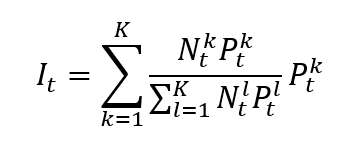
where I is the index value, k a given asset, K the number of assets in the index, Pk the market price of asset k, Nk the number of issued shares for asset k, and t the time of calculation of the index.
In a S&P 500 index, the weight of asset k is given by formula can be rewritten as
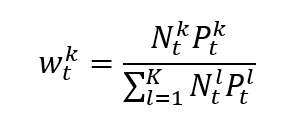
which clearly shows that the weight of each asset in the index is its market capitalization of the asset divided by the sum of the market capitalizations of all assets.
The divisor, whose calculation is based on the number of shares, is typically adjusted for events such as stock splits and dividends. The divisor is used to ensure that the value of the index remains consistent over time despite changes in the number of outstanding shares.
Note that there are two versions of the S&P 500 index: one which includes the performance of the company as well as the dividends the companies pay (so it is a dividend included index), and another one which only considers the performance of the company but does not consider the dividends.
Use of the S&P 500 index in asset management
Given that the index is used for performance measuring it is widely used for constructing and analyzing investment portfolios. This index’s primary use is to create investment strategies, mitigate risk, and assess portfolio performance. Investors and asset managers utilize this index as an useful index to measure the overall performance of the market.
Benchmark for equity funds
There are a number of indices used as a benchmark for equity funds but the S&P 500 index particularly focuses on the large capped companies in the US market. It is mainly differentiated by the asset class the index is focusing on and the investment strategies followed by the companies. For Example: DJIA uses price weighted stock strategy for the top 30 blue chip companies, whereas the NASDAQ Composite Index uses market capitalization-weighted index of more than 3,000 stocks in the NASDAQ Composite.
Financial products around the S&P 500 index
There are a number of financial products that either provide exposure to the index or use information from the index. Not just the index funds but there are numerous ETFs and specific sector related indices which provide exposure to the S&P 500 index. Other financial products would be mutual funds, futures and options etc.
Historical data for the S&P 500 index
How to get the data?
The S&P 500 index is the most common index used in finance, and historical data for the S&P 500 index can be easily downloaded from the internet.
For example, you can download historical data for the S&P 500 index from December 30, 1927 on Yahoo! Finance (the Yahoo! code for S&P 500 index is ^GSPC).
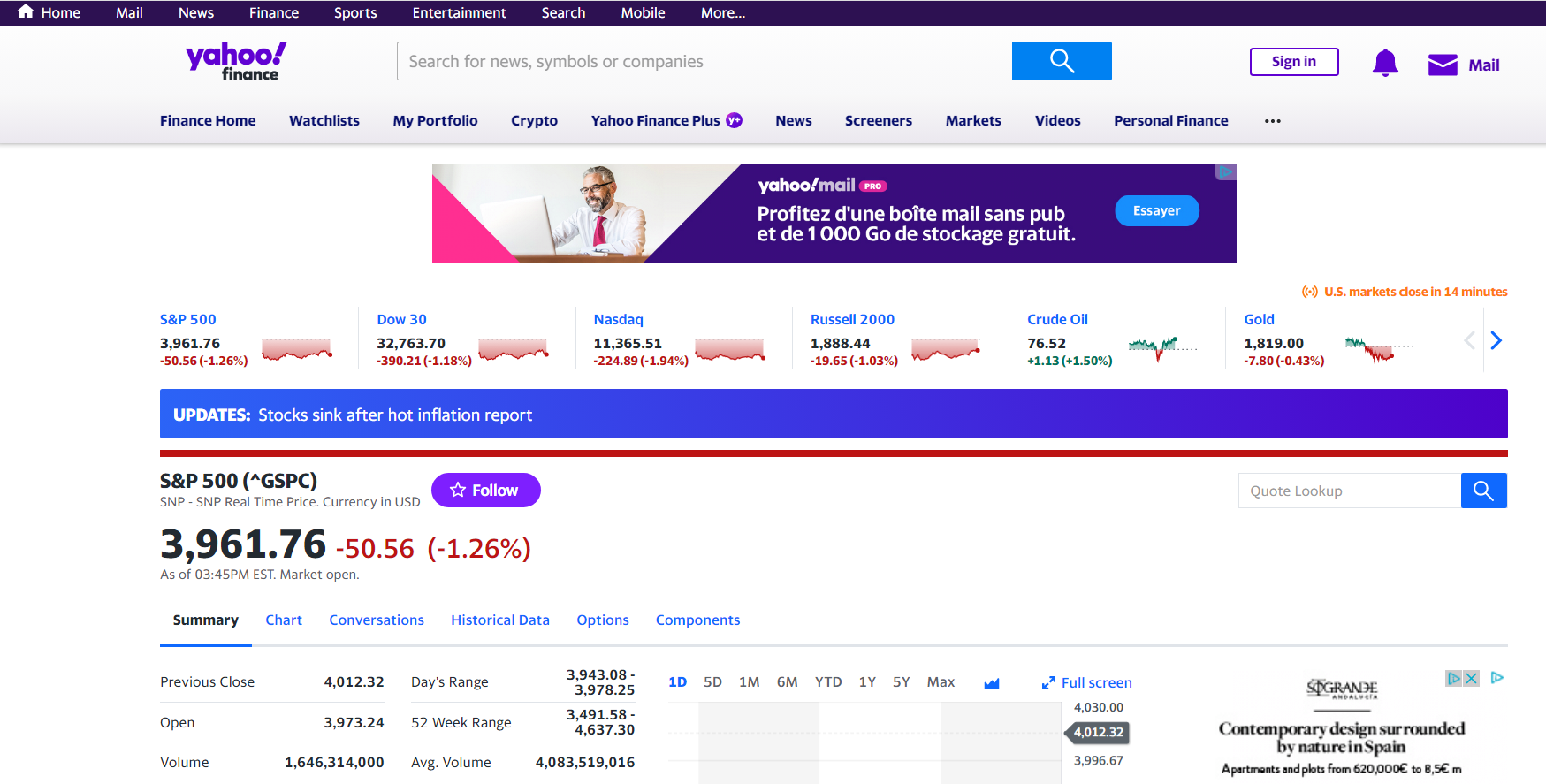
Source: Yahoo! Finance.
You can also download the same data from a Bloomberg terminal.
R program
The R program below written by Shengyu ZHENG allows you to download the data from Yahoo! Finance website and to compute summary statistics and risk measures about the S&P 500 index.
Data file
The R program that you can download above allows you to download the data for the S&P 500 index from the Yahoo! Finance website. The database starts on December 30, 1927. It also computes the returns (logarithmic returns) from closing prices.
Table 3 below represents the top of the data file for the S&P 500 index downloaded from the Yahoo! Finance website with the R program.
Table 3. Top of the data file for the S&P 500 index.
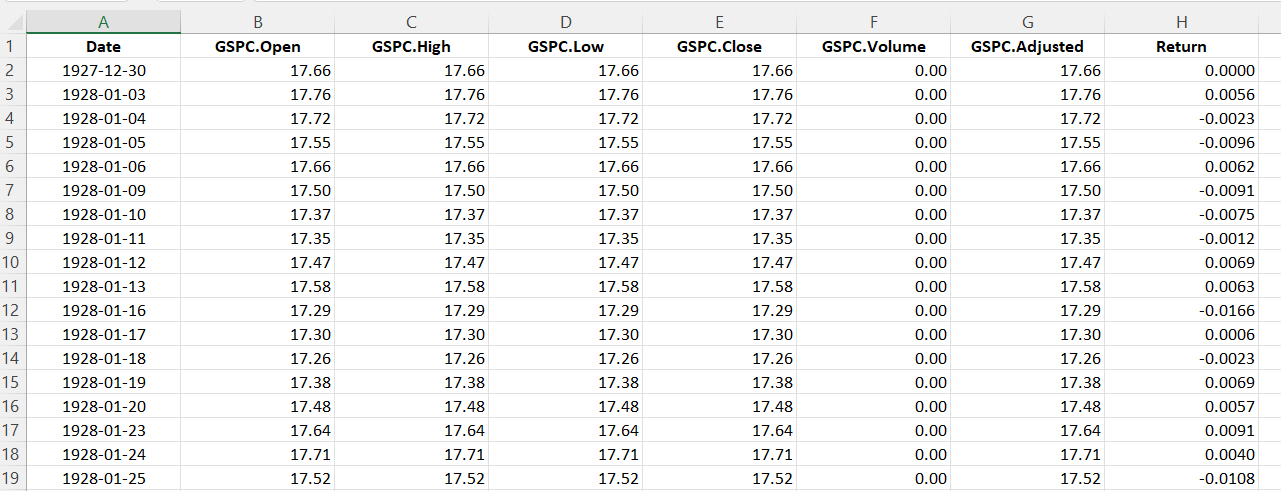
Source: computation by the author (data: Yahoo! Finance website).
Summary statistics for the S&P 500 index
The R program that you can download above also allows you to compute summary statistics about the returns of the S&P 500 index.
Table 4 below presents the following summary statistics estimated for the S&P 500 index:
- The mean
- The standard deviation (the squared root of the variance)
- The skewness
- The kurtosis.
The mean, the standard deviation / variance, the skewness, and the kurtosis refer to the first, second, third and fourth moments of statistical distribution of returns respectively.
Table 4. Summary statistics for the S&P 500 index.
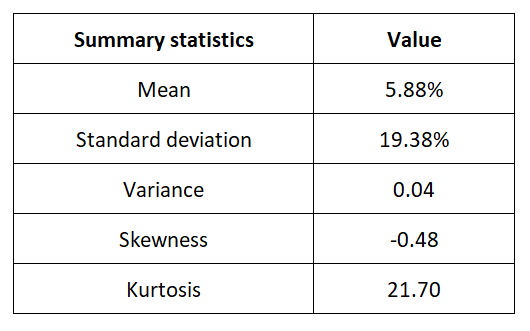
Source: computation by the author (data: Yahoo! Finance website).
Evolution of the S&P 500 index
Figure 1 below gives the evolution of the S&P 500 index from December 30, 1927 to December 30, 2022 on a daily basis.
Figure 1. Evolution of the S&P 500 index.
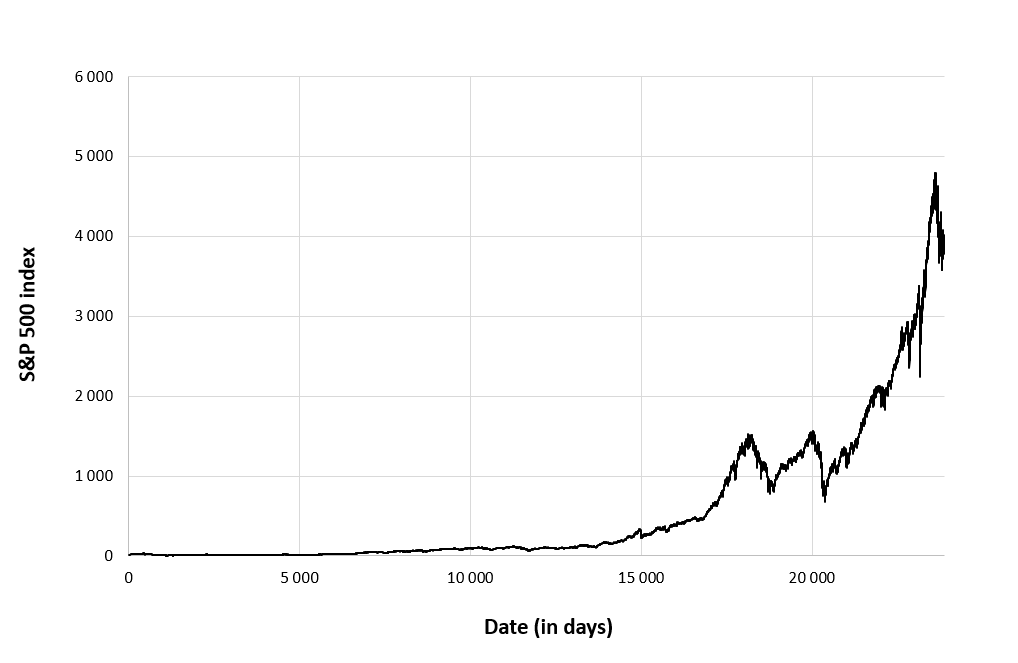
Source: computation by the author (data: Yahoo! Finance website).
Figure 2 below gives the evolution of the S&P 500 index returns from December 30, 1927 to December 30, 2022 on a daily basis.
Figure 2. Evolution of the S&P 500 index returns.
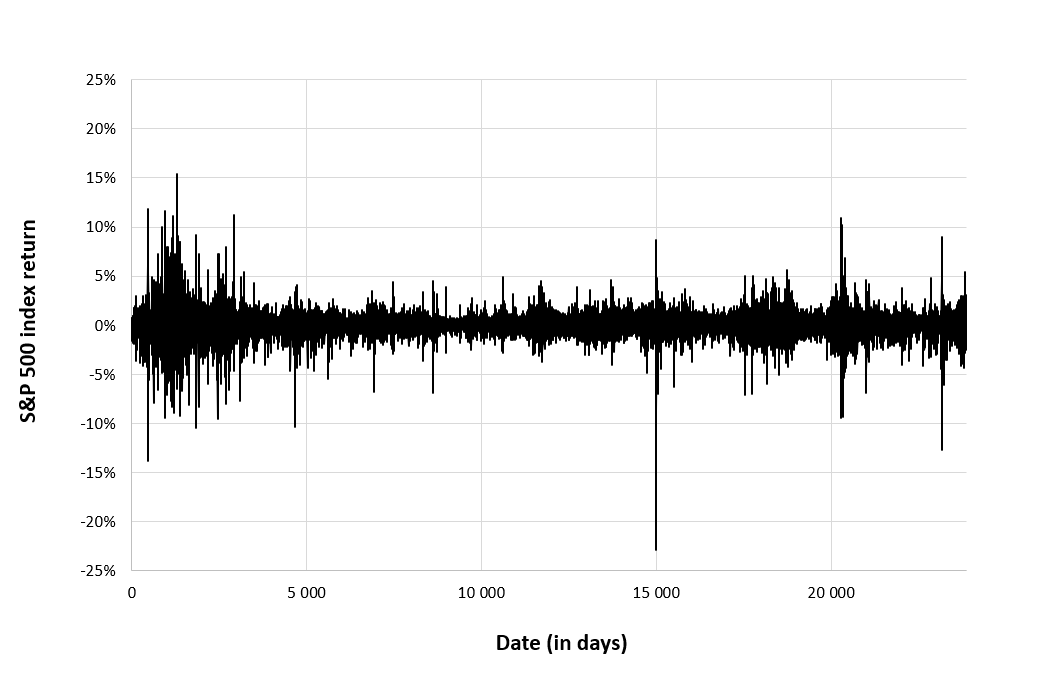
Source: computation by the author (data: Yahoo! Finance website).
Statistical distribution of the S&P 500 index returns
Historical distribution
Figure 3 represents the historical distribution of the S&P 500 index daily returns for the period from December 30, 1927 to December 30, 2022.
Figure 3. Historical distribution of the S&P 500 index returns.
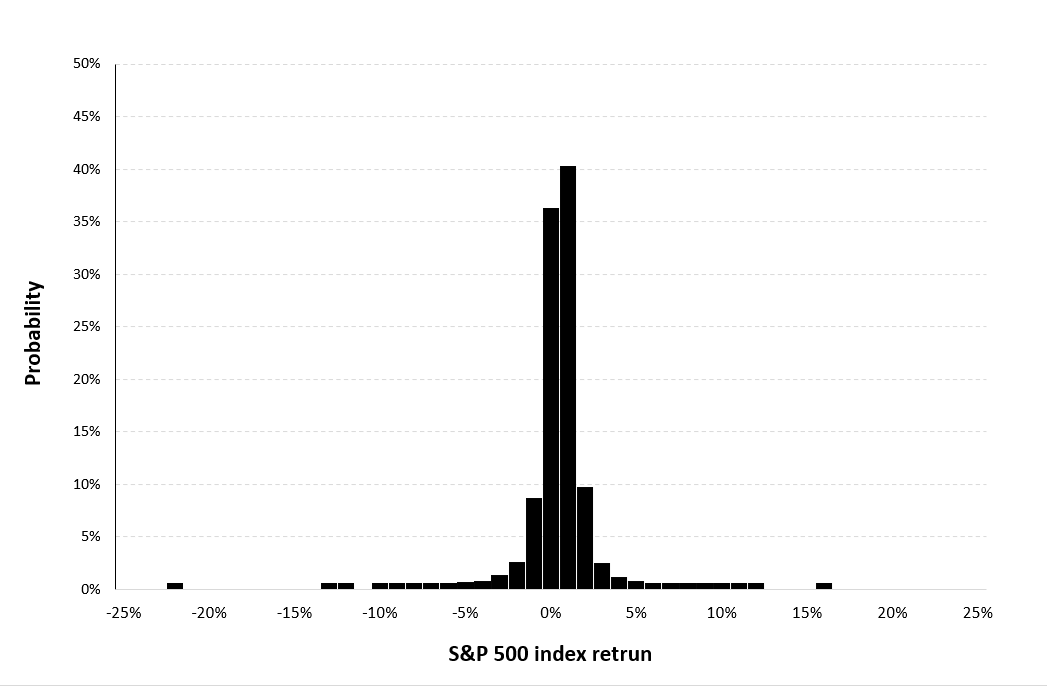
Source: computation by the author (data: Yahoo! Finance website).
Gaussian distribution
The Gaussian distribution (also called the normal distribution) is a parametric distribution with two parameters: the mean and the standard deviation of returns. We estimated these two parameters over the period from December 30, 1927 to December 30, 2022. The mean of daily returns is equal to 0.02% and the standard deviation of daily returns is equal to 1.20% (or equivalently 5.88% for the annual mean and 19.38% for the annual standard deviation as shown in Table 3 above).
Figure 4 below represents the Gaussian distribution of the S&P 500 index daily returns with parameters estimated over the period from December 30, 1927 to December 30, 2022.
Figure 4. Gaussian distribution of the S&P 500 index returns.
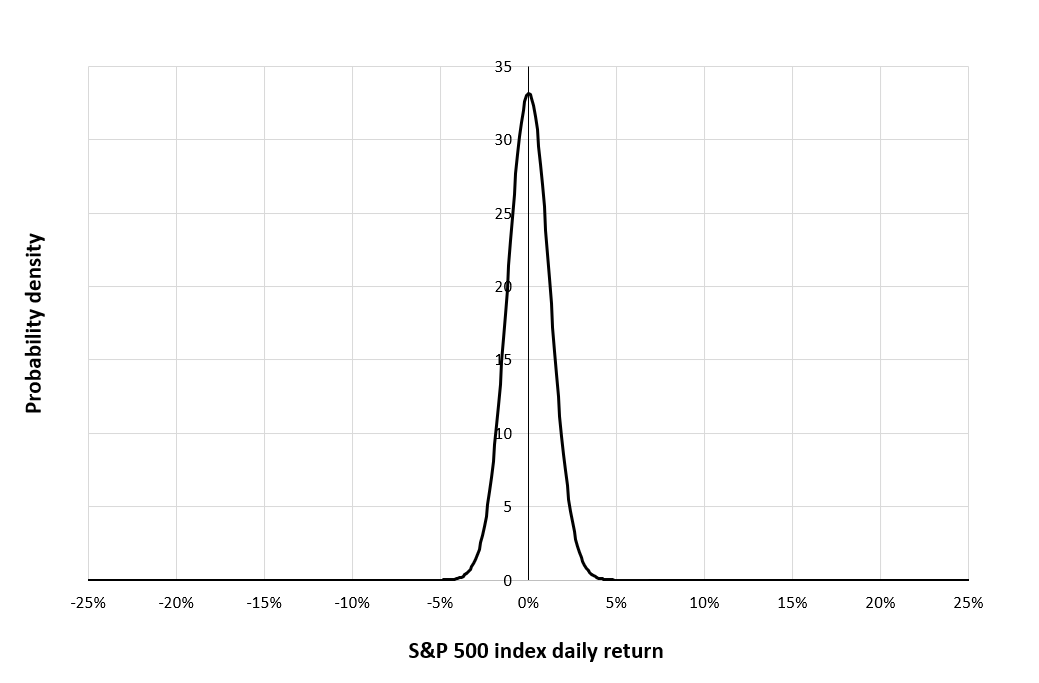
Source: computation by the author (data: Yahoo! Finance website).
Risk measures of the S&P 500 index returns
The R program that you can download above also allows you to compute risk measures about the returns of the S&P 500 index.
Table 5 below presents the following risk measures estimated for the S&P 500 index:
- The long-term volatility (the unconditional standard deviation estimated over the entire period)
- The short-term volatility (the standard deviation estimated over the last three months)
- The Value at Risk (VaR) for the left tail (the 5% quantile of the historical distribution)
- The Value at Risk (VaR) for the right tail (the 95% quantile of the historical distribution)
- The Expected Shortfall (ES) for the left tail (the average loss over the 5% quantile of the historical distribution)
- The Expected Shortfall (ES) for the right tail (the average loss over the 95% quantile of the historical distribution)
- The Stress Value (SV) for the left tail (the 1% quantile of the tail distribution estimated with a Generalized Pareto distribution)
- The Stress Value (SV) for the right tail (the 99% quantile of the tail distribution estimated with a Generalized Pareto distribution)
Table 5. Risk measures for the S&P 500 index.
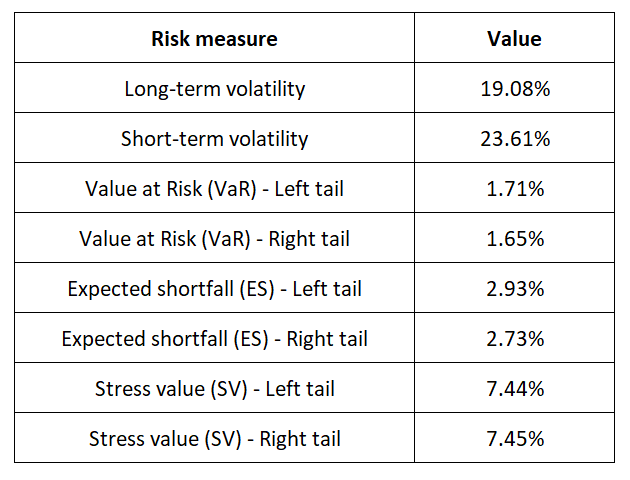
Source: computation by the author (data: Yahoo! Finance website).
The volatility is a global measure of risk as it considers all the returns. The Value at Risk (VaR), Expected Shortfall (ES) and Stress Value (SV) are local measures of risk as they focus on the tails of the distribution. The study of the left tail is relevant for an investor holding a long position in the S&P 500 index while the study of the right tail is relevant for an investor holding a short position in the S&P 500 index.
Why should I be interested in this post?
For a number of reasons, ESSEC students should learn about the S&P 500 index. The performance of 500 large-cap American companies is tracked by this stock market index, which is first and foremost well-known and respected. Gaining a deeper understanding of the US stock market and the businesses that fuel its expansion requires knowledge of the S&P 500 index. Management students can assess the performance of their own investments and those of their organization by comprehending the S&P 500 index and its components. Last but not least, a lot of businesses base their mutual funds and exchange-traded funds (ETFs) on the S&P 500 index.
Related posts on the SimTrade blog
About financial indexes
▶ Nithisha CHALLA Financial indexes
▶ Nithisha CHALLA Calculation of financial indexes
▶ Nithisha CHALLA The business of financial indexes
▶ Nithisha CHALLA Float
About other US financial indexes
▶ Nithisha CHALLA The DJIA index
▶ Nithisha CHALLA The NASDAQ index
▶ Nithisha CHALLA The Russell 2000 index
▶ Nithisha CHALLA The Wilshire 5000 index
About portfolio management
▶ Jayati WALIA Returns
▶ Youssef LOURAOUI Portfolio
About statistics
▶ Shengyu ZHENG Moments de la distribution
▶ Shengyu ZHENG Mesures de risques
Useful resources
Academic research about risk
Longin F. (2000) From VaR to stress testing: the extreme value approach Journal of Banking and Finance, N°24, pp 1097-1130.
Longin F. (2016) Extreme events in finance: a handbook of extreme value theory and its applications Wiley Editions.
Data: Yahoo! Finance
Yahoo! Finance Historical data for the S&P 500 index
Data: Bloomberg
Bloomberg Data for the S&P 500 index
About the author
The article was written in March 2023 by Nithisha CHALLA (ESSEC Business School, Grande Ecole Program – Master in Management, 2021-2023).



Pingback: Extreme Value Theory: the Block-Maxima approach and the Peak-Over-Threshold approach - SimTrade blogSimTrade blog